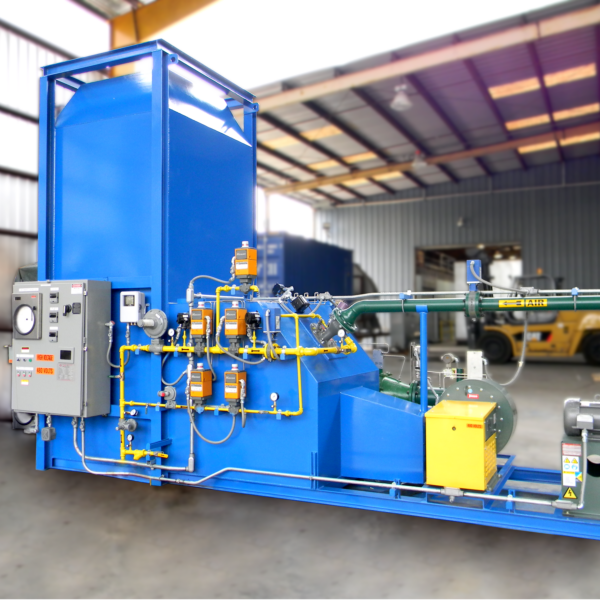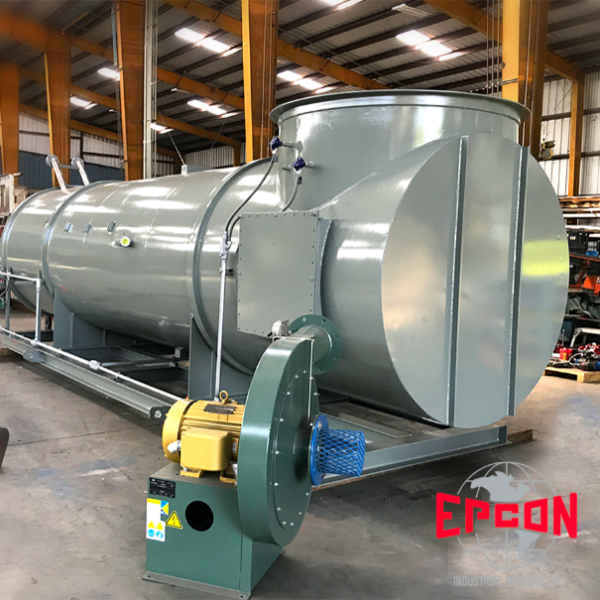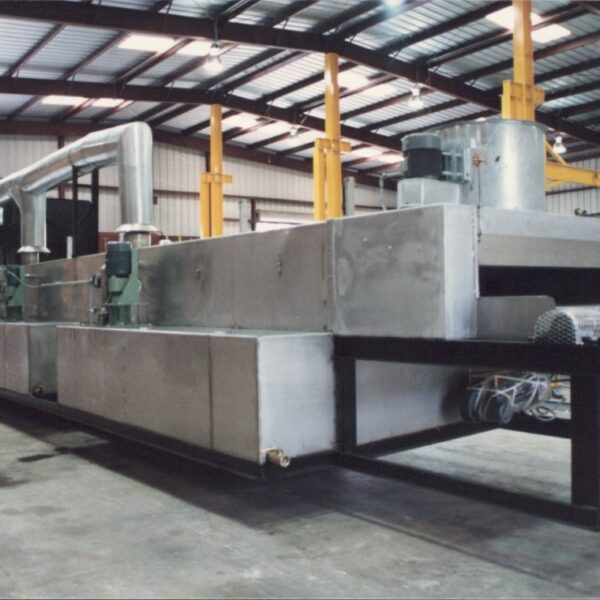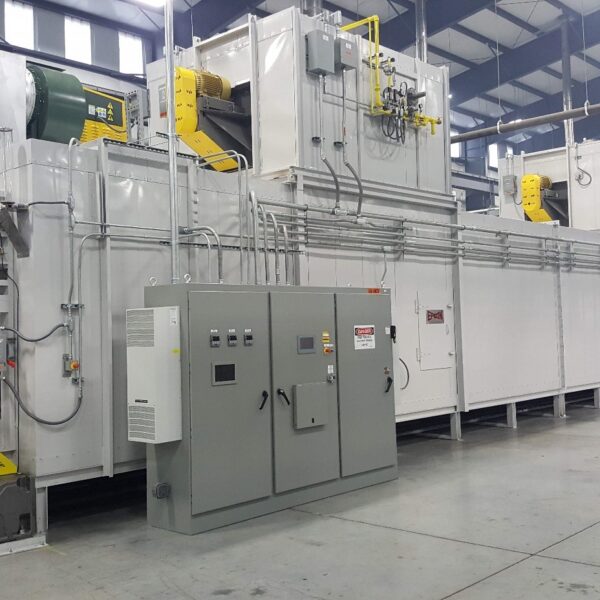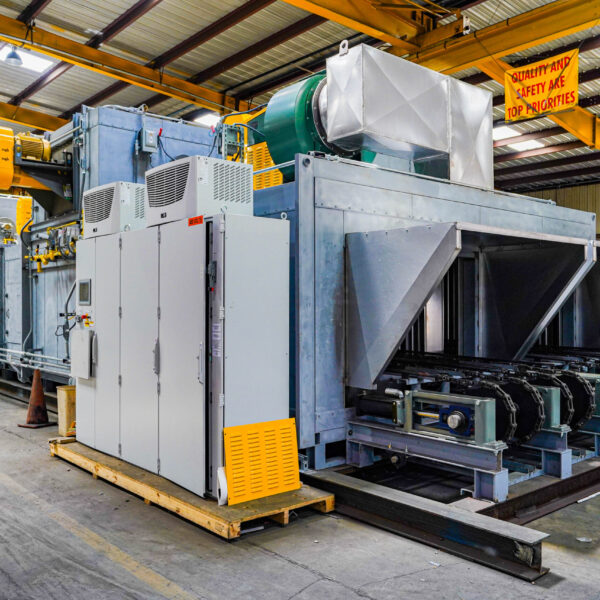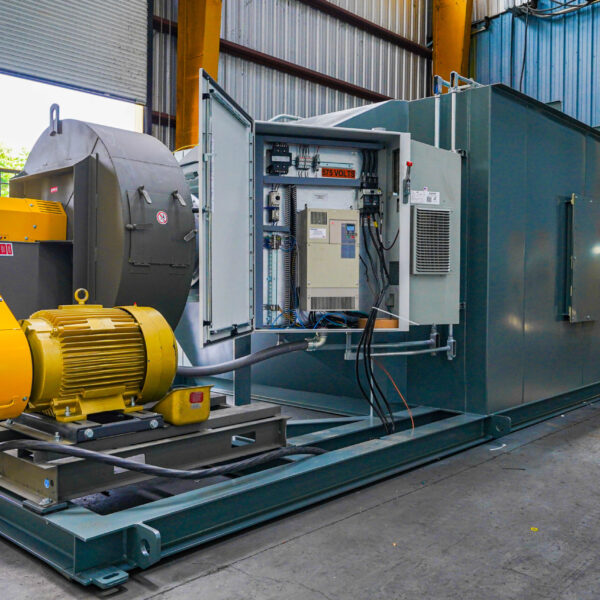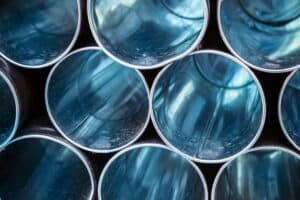Heat Exchangers
Epcon’s unique patented heat recovery systems and our commitment to innovation keep us on the cutting edge of technology. Epcon is one of the few companies to have its own state-of-the-art heat exchanger manufacturing facility on site.
Our Shell and Tube Heat Exchangers are designed to transfer heat efficiently and effectively while reducing fuel consumption. A Heat Exchanger can be combined with any of our other systems or as a retrofit. In addition, Epcon has several designs that combine burnerless ovens with Thermal Oxidizers to create a completely integrated Combination Oven/Oxidizer System.
The price of the fuel necessary to run fired equipment (Ovens, Oxidizers, etc) can be exorbitant. In order to lower operating costs, a heat exchanger can be used. Heat Exchangers are used for transferring heat from one fluid (such as air) at higher temperature to another fluid at a lower temperature, thus making use of heat which would otherwise be wasted. In the various systems manufactured at Epcon, heat exchangers are used for the following purposes:
- Pre-Heating the process gas as it enters the thermal oxidizer (also called Primary heat exchanger). The heat is transferred from the hot gas leaving the combustion process to the cold air entering it. The two basic methods are Regenerative and Recuperative.
- Using the gas for Secondary heating systems, such as process heating of the manufacturing facilities and heating boilers.
Regenerative & Recuperative Heat Exchangers
The two major types of primary heat recovery are Recuperative and Regenerative heat exchanger systems.
Recuperative systems typically employ shell and tube type heat exchangers. In these heat exchangers, a stream of cold process gas passes through a series of tubes and is heated by another stream of gas which passes over the tubes on the shell side. These types of systems are generally used for thermal oxidizers with low to medium process flow rate, and generally can provide up to 80% thermal energy recovery efficiency.
Regenerative type heat exchangers use a media to absorb heat given off by one hotter fluid and transfer it to another colder fluid. Typical medias used are packed towers of ceramic material with required gaps for the gases to pass through them. The operation of regenerative heat exchangers is cyclic. In the first cycle hot gases/fluids passing through the media to heat up the media. In the following cycle, the cold gases pass through the media and they are heated by the already hot media. Regenerative systems can operate with process flow rates in the low or high range and can yield a thermal energy recovery efficiency up to 95%+.
Economizers
An economizer is a type of heat exchanger that recovers waste heat from flue gasses to preheat fluids or puts it to use in another part of the production process. Several different types of economizers are available for different applications, such as include finned tubes, coiled tubes, non-condensing, and condensing economizers, but they all serve the same functionality. The condensing and non-condensing types are mainly used to improve the efficiency of boiler systems, whereas the other types are commonly used in thermal power plants and large processing units to recover waste heat from the flue gas.
Economizers or finned tube heat exchangers recover low to medium waste heat and are mainly used for heating liquids. The system consists of tubes that is covered by metallic fins to maximize the surface area of heat absorption and the heat transfer rate. Liquid is passed through the tubes and captures heat; the hot liquid is then fed back to the system, maximizing, and improving the thermal efficiency.
An indirect contact or direct contact condensing economizer will recover the residual heat from the combustion products, saving on both fuel consumption and costs, as well as reducing the CO2 emission.
Heat Exchanger Effectiveness
At Epcon, these heat exchangers are used to transfer heat from hot gases at 1500°F to cold gases which are in the range of -10°F to 500°F. Effectiveness is a measure of the performance of a heat exchanger and is defined as the ratio of rate of heat transfer to the maximum possible heat transfer. The mathematical expression for the effectiveness of heat exchanger is given by the following equation expressed.
E = (Rate of heat transfer in heat exchanger)
(Maximum possible heat transfer rate)
E = mc Cpc (Tce – Tci) / (m Cp)s (Thi-Tci)
When the heat from the hot gases is used to preheat the gases going to the combustion chamber, the mass flow rates and specific heat of incoming and outgoing gases remains the same. We use the following expression for finding the effectiveness of heat exchanger, the equation below applies.
E = (Thi-The) / (Thi-Tci)
Where E = Effectiveness
Thi = Temperature of incineration
The = Temperature exiting heat exchanger
Tci = Temperature cold entering heat exchanger
As the effectiveness of the heat exchanger increases, the heat recovery from a given stream of hot gases also increases. Generally regenerative heat recovery offers greater heat recovery options, where recuperative recovery has plateaued at 80%, regenerative heat recovery can have an effectiveness of almost 95%, or even more in some situations.
In a Recuperative system, the surface area of the heat exchanger tubes is the surface area available for heat transfer to take place. For higher effectiveness, this area needs to be increased. In other words, the number of tubes in the heat exchanger have to be increased. Longer heat exchanger obviously has more initial costs, but these are quickly repaid through fuel efficiency.
Heat Exchangers are designed to achieve a predetermined amount of effectiveness. The quantity of air flow on the shell and tube sides of the heat exchanger is known. Also known is the temperature range in which the heat exchanger is expected to operate. The design parameters which are important are heat exchanger tube lengths and number of tubes.
Through years of experience and experimentation, Epcon has built up a database of heat exchanger designs based on 100’s of applications which accelerates concept development and insures successful system sizing. Epcon utilizes advanced computer modeling software, supported by our database of installations, for analyzing and determining the number of tubes required for designing the heat exchanger. Epcon always allows for a sufficient factor of safety and provides more than required area for heat transfer. Thus, we always prioritize system reliability and robustness to insure customer satisfaction for the life of the system.
Example of the advantage of using a Heat Exchanger:
Compare the mass flow rate of natural gas required to heat 10,000 SCFM of an exhaust process gas from 70°F to 1400°F, for a system without a heat exchanger and system with a 70% effective heat exchanger. Assume that the available heat of the natural gas is 950 BTU/SCF and that there is no heat loss. The average heat capacity over this range may be assumed to be 7.5 BTU/lb mol.
Molar flow rate of process gas:
E = (Thi-The) / (Thi-Tci)
Where E = Effectiveness
Thi = Temperature of incineration
The = Temperature exiting heat exchanger
Tci = Temperature cold entering heat exchange
Heat required to incinerate:
E = (Thi-The) / (Thi-Tci)
Where E = Effectiveness
Thi = Temperature of incineration
The = Temperature exiting heat exchanger
Tci = Temperature cold entering heat exchange
Which changes the total heat required to:
Q = (26.4) (7.5) (1400-1001) = .79 x 105 Btu/min
Making the total Natural Gas required:
NG = Q/HA = (.79 x 105 / 950) = 83.15 scfm
Which is a savings of almost 300% in natural gas!
From theoretical to the practical, understanding the thermal stresses imparted upon a heat exchanger as well as the factors which influence heat exchange efficiency and pressure drop within the unit and overall system are critical to designing a capable system.
Heat Exchanger design and fabrication is a job that requires specialized tools/software, knowledgebase of practical applications, highly qualified engineers, skilled craftspeople, all with the experience and passion to produce world class products. Epcon has proven its capabilities and excels in all these categories.
Manufacturing Considerations
Fabrication of shell and tube type heat exchangers includes cutting the tubes and side sheets, punching holes in the side sheets, welding the tubes, expansion joint and side sheets. The processes and procedures developed at Epcon for the critical welds are one of the keys to producing the high-quality, high-performance heat exchangers employed on all of our Air Pollution Control, Ovens and Finishing Systems.
Manufacturing in-house allows Epcon to control quality and performance from concept through execution. Delivering standard and custom engineered Air Pollution Control, Ovens and Furnaces, Finishing Systems and Specialty Systems that meet and exceed our customer’s requirements at prices they can afford.
